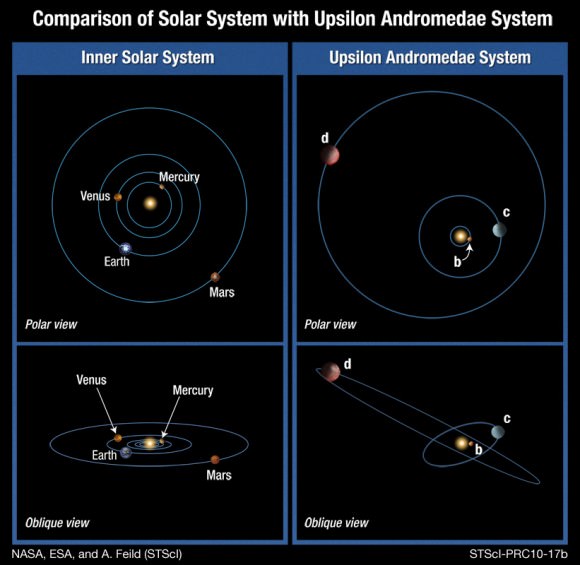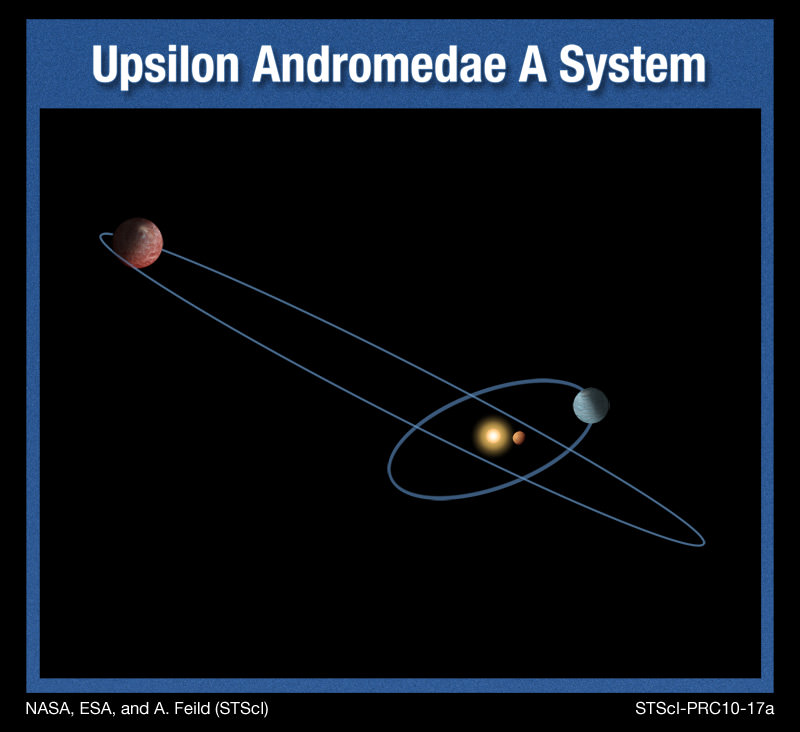[/caption]
Astronomers are finding that not only are there a wide range of different extrasolar planets, but there are different types of planetary systems, as well. “We’re not in Kansas anymore as far as solar systems go,” said Barbara McDonald from the University of Texas’ McDonald Observatory, at the American Astronomical Society meeting in Miami, Florida today. “The exciting thing is, we found another multi-planet system that is not at all like our own.”
A close look at the Upsilon Andromedae system with the Hubble Space Telescope, the Hobby-Eberly Telescope and other ground-based telescopes shows a whacky system where planets are out of tilt and have highly inclined orbits. The astronomers also found another planet, and also another star – this is likely a binary star system.
Even with Pluto’s inclined orbit, our solar system looks like an ocean of calm compared to Upsilon Andromedae.

McDonald said these surprising findings will impact theories of how multi-planet systems evolve, and it shows that some violent events can happen to disrupt planets’ orbits after a planetary system forms.
“The findings mean that future studies of exoplanetary systems will be more complicated,” she said. “Astronomers can no longer assume all planets orbit their parent star in a single plane.” says Barbara McArthur of The University of Texas at Austin’s McDonald Observatory.
Similar to our Sun in its properties, Upsilon Andromedae lies about 44 light-years away. It’s a little younger, more massive, and brighter than the Sun. For just over a decade, astronomers have known that three Jupiter-type planets orbit the yellow-white star Upsilon Andromedae.
But after over a thousand combined observations, McDonald and her team uncovered hints that a fourth planet, e, orbits the star much farther out. They were also able to determine the exact masses of two of the three previously known planets, Upsilon Andromedae c and d. Much more startling, though, is that not all planets orbit this star in the same plane. The orbits of planets c and d are inclined by 30 degrees with respect to each other. This research marks the first time that the “mutual inclination” of two planets orbiting another star has been measured.
“Most probably Upsilon Andromedae had the same formation process as our own solar system, although there could have been differences in the late formation that seeded this divergent evolution,” McArthur said. “The premise of planetary evolution so far has been that planetary systems form in the disk and remain relatively co-planar, like our own system, but now we have measured a significant angle between these planets that indicates this isn’t always the case.”
Until now the conventional wisdom has been that a big cloud of gas collapses down to form a star, and planets are a natural byproduct of leftover material that forms a disk. In our solar system, there’s a fossil of that creation event because all of the eight major planets orbit in nearly the same plane. The outermost dwarf planets like Pluto are in inclined orbits, but these have been modified by Neptune’s gravity and are not embedded deep inside the Sun’s gravitational field.
So what knocked the Upsilon Andromedae system around?
“Possibilities include interactions occurring from the inward migration of planets, the ejection of other planets from the system through planet-planet scattering, or disruption from the parent star’s binary companion star, Upsilon Andromedae B,” McArthur said.
Or, the companion star – a red dwarf less massive and much dimmer than the Sun — could be the culprit. is.
“We don’t have any idea what its orbit is,” said team member Fritz Benedict. “It could be very eccentric. Maybe it comes in very close every once in a while. It may take 10,000 years.” Such a close pass by the secondary star could gravitationally perturb the orbits of the planets.”
The two different types of data combined in this research were astrometry from the Hubble Space Telescope and radial velocity from ground-based telescopes.
Astrometry is the measurement of the positions and motions of celestial bodies. McArthur’s group used one of the Fine Guidance Sensors (FGSs) on the Hubble telescope for the task. The FGSs are so precise that they can measure the width of a quarter in Denver from the vantage point of Miami. It was this precision that was used to trace the star’s motion on the sky caused by its surrounding — and unseen — planets.
Radial velocity makes measurements of the star’s motion on the sky toward and away from Earth. These measurements were made over a period of 14 years using ground-based telescopes, including two at McDonald Observatory and others at Lick, Haute-Provence, and Whipple Observatories. The radial velocity provides a long baseline of foundation observations, which enabled the shorter duration, but more precise and complete, Hubble observations to better define the orbital motions.
The fact that the team determined the orbital inclinations of planets c and d allowed them to calculate the exact masses of the two planets. The new information told us that our view as to which planet is heavier has to be changed. Previous minimum masses for the planets given by radial velocity studies put the minimum mass for planet c at 2 Jupiters and for planet d at 4 Jupiters. The new, exact masses, found by astrometry are 14 Jupiters for planet c and 10 Jupiters for planet d.
“The Hubble data show that radial velocity isn’t the whole story,” Benedict said. “The fact that the planets actually flipped in mass was really cute.”
The fourth planet is so far out, that its signal does not reveal the curvature of its orbit.
The 14 years of radial velocity information compiled by the team uncovered hints that a fourth, long-period planet may orbit beyond the three now known. There are only hints about that planet because it’s so far out that the signal it creates does not yet reveal the curvature of an orbit. Another missing piece of the puzzle is the inclination of the innermost planet, b, which would require precision astrometry 1,000 times greater than Hubble’s, a goal attainable by a future space mission optimized for interferometry.
Sources: HubbleSite, AAS Press conference


This is an odd ball stellar system. Given the age of the system it likely has been this way for some time. These two planetary orbits, planets c and d, are dynamically similar to two coupled gyroscopes. They likely exchange angular momentum over time, but since the system is conservative (energy is constant in the orbits) the precessions in the inclinations of these orbits oscillates over time and repeats.
The nebular hypothesis, which in a nutshell is what most of this domain of astrophysics operates on, might still in some general sense operate. If I had to propose a hypothesis it might be that eps-And formed by two disks of gas and the two gravitationally collapsed into these planets before friction between them resulted in a single cloud in a single planar disk. That would be my first operating idea until for some reason it fails.
LC
D’oh! HTML et cetera fail:
Hot Jupiter migrations which end up with inclined and even retrograde systems (here are 6 of them that UT covered recently) ) have been seen before.
This was already noted over on Bad Astronomy, but the heavy mass planet yet again hints (at least for this layman) that it can be problematic to use fusion as criteria for the gray area between planets and brown dwarfs. Again, specific traits doesn’t seem to be telling us much about the population and its history – its analogous fossil state, as the article puts it.
As for the models that predict the fossil state, migration and scattering seems common enough, while disruption and twin disks is AFAIU not observed often or at all. Hot Jupiters migrations which end up with inclined and even retrograde systems (here are 6 of them that UT covered recently) have been sen before. Since I don’t have a pet axe to grind or wouldn’t know how to get one in planetary system dynamics, I’m for now putting my money where the statistics are. 😀
I’m with TL… Have no idea how they got this way. There are many ways it could happen, one just as likely as the other.
I always was wondering why other solar systems would look just like us.
I mean a crossing star could gravitational influence the planets in such a way that they get through out of the plane because of a gravity assist.
@Olaf
I was thinking the same thing. I imagine they’ve already taken an inventory of the immediate area of this solar system, but a perturbation caused by a wandering star or black hole could be as likely a candidate as any for the orbital characteristics of these planets.
I recall that beta Pictoris has a secondary dust disk (inclined 4 degrees from the primary, ref: STScI-2006-25). Still, such things are extremely rare; I’m inclined to think the red dwarf did it. 🙂
@PhelanKA7
Even if they have indeed taken a local inventory, they could still very much miss a vast majority of the objects that could perturb these planets over the timescales we are talking about. Don’t forget stars do a great deal of wandering too in their lifetimes.
One thing I do know, if you look at our solar system, then nothing big has passed in the last 4.5 billion years.
Maybe the problem is that we are too stuck on the idea that planetary systems form in disks. A disk might in some cases be thickened so it is a sort of tube with some azimuthal (Z-direciton) mass distribution. The material is in a radial orbit plus an oscillatory motion along the aximuthal direction. The motion in the azimuthal direction then gets into various resonance condtions which might then establish orbits with inclinations seen here.
LC
Hopefully, this will be a final blow to the “universe is orderly” crowd. And to the “orbital zones” nonsense.
As others have noted, this can be produced in a number of ways. As far as I’m concerned, and if I were of the gambling type, I’d put my money on a passing star, although the binary companion, if its orbit is significantly inclined with respect to the plane of rotation of the inner planets and/or of Ups And A, also has a high probability of being the culprit, in my view.
But the most significant in this find, as with recent finds of other backward rotating or highly inclined planets, is making it absolutely clear that planetary formation is intrinsically a chaotic process, not at all deterministic, and that a planetary system (forming or formed) is not a closed system.
The problem with the passing star theory is that the star would have to come close, the probability for this with any star is not that large (to make a reasonable guess) and there seem to be a number of stellar systems with strangely alligned planetary inclinations.
LC